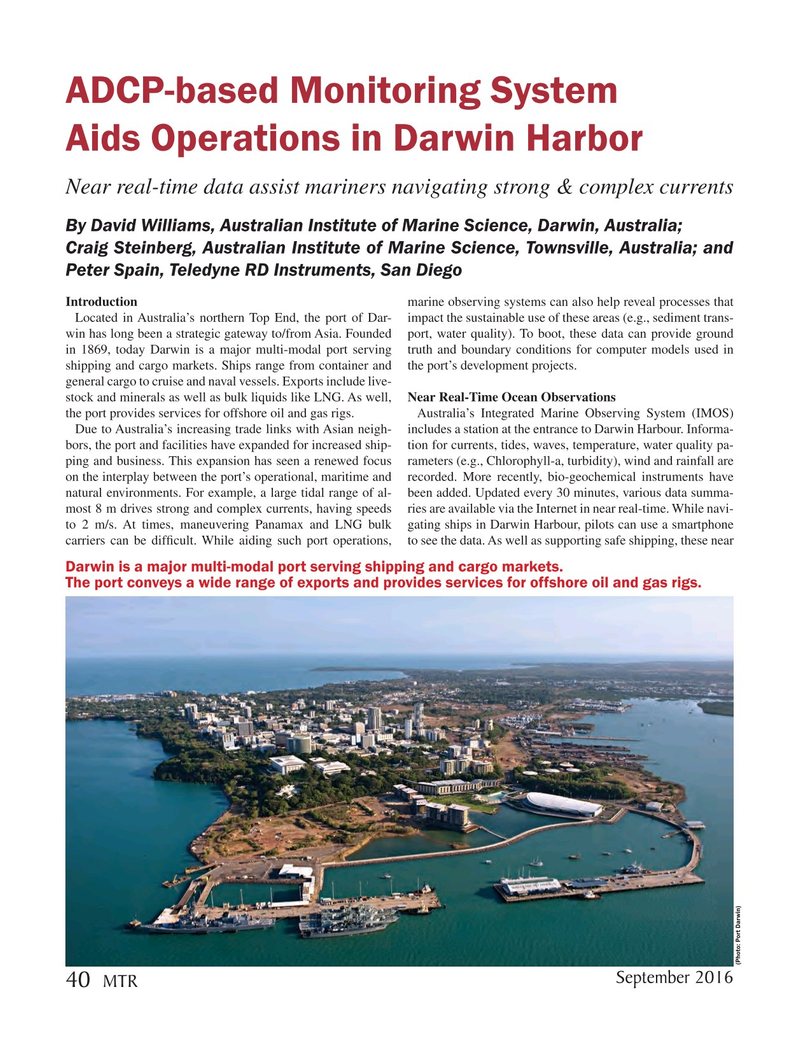
Page 40: of Marine Technology Magazine (September 2016)
Ocean Observation: Gliders, Buoys & Sub-Surface Networks
Read this page in Pdf, Flash or Html5 edition of September 2016 Marine Technology Magazine
ADCP-based Monitoring System
Aids Operations in Darwin Harbor
Near real-time data assist mariners navigating strong & complex currents
By David Williams, Australian Institute of Marine Science, Darwin, Australia;
Craig Steinberg, Australian Institute of Marine Science, Townsville, Australia; and
Peter Spain, Teledyne RD Instruments, San Diego
Introduction marine observing systems can also help reveal processes that
Located in Australia’s northern Top End, the port of Dar- impact the sustainable use of these areas (e.g., sediment trans- win has long been a strategic gateway to/from Asia. Founded port, water quality). To boot, these data can provide ground in 1869, today Darwin is a major multi-modal port serving truth and boundary conditions for computer models used in shipping and cargo markets. Ships range from container and the port’s development projects. general cargo to cruise and naval vessels. Exports include live- stock and minerals as well as bulk liquids like LNG. As well, Near Real-Time Ocean Observations the port provides services for offshore oil and gas rigs. Australia’s Integrated Marine Observing System (IMOS)
Due to Australia’s increasing trade links with Asian neigh- includes a station at the entrance to Darwin Harbour. Informa- bors, the port and facilities have expanded for increased ship- tion for currents, tides, waves, temperature, water quality pa- ping and business. This expansion has seen a renewed focus rameters (e.g., Chlorophyll-a, turbidity), wind and rainfall are on the interplay between the port’s operational, maritime and recorded. More recently, bio-geochemical instruments have natural environments. For example, a large tidal range of al- been added. Updated every 30 minutes, various data summa- most 8 m drives strong and complex currents, having speeds ries are available via the Internet in near real-time. While navi- to 2 m/s. At times, maneuvering Panamax and LNG bulk gating ships in Darwin Harbour, pilots can use a smartphone carriers can be dif? cult. While aiding such port operations, to see the data. As well as supporting safe shipping, these near
Darwin is a major multi-modal port serving shipping and cargo markets.
The port conveys a wide range of exports and provides services for offshore oil and gas rigs.
(Photo: Port Darwin)
September 2016 40
MTR
MTR #7 (34-49).indd 40 8/24/2016 1:36:31 PM

 39
39

 41
41
